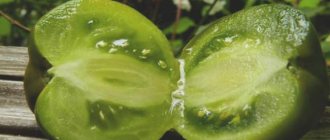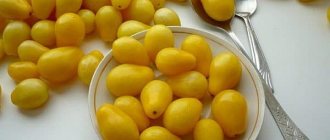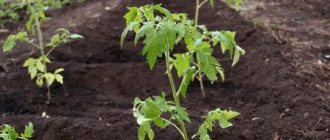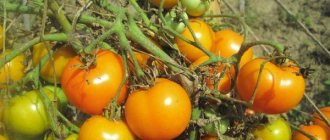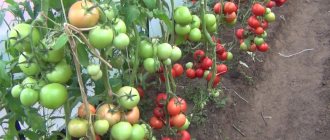This hybrid is for those who are looking for beauty and tenderness of taste. The Swan Princess tomato F1 inspires chefs to create delicacies - original and classic. Gardeners get a lot of pleasure from growing and bountiful harvests.
| Height | Landing location | Ripening time | Fruit color | Fruit size | Origin | Fruit shape |
| Medium height | Greenhouse, Open ground | Mid-early | Reds | Average | Hybrid | Plum-shaped or oval |
Description and characteristics of the variety
Tomato Swan Princess F1 is a hybrid determinant in the first generation. He is of medium height. Designed for planting in open areas and sheltered greenhouses. The bushes are distinguished by the following characteristic features:
- trunk height is within 1.5-1.6 m;
- the first cluster is tied after 7-8 leaves;
- fruiting clusters contain 5-7 tomatoes;
- foliage is medium, semi-spreading;
- leaves are typical, dark green.
Ripening occurs in the mid-early period. Harvesting begins 98-110 days after emergence.
Tomato Description:
- average weight varies between 320-350 g;
- the skin is durable, does not crack or become damaged;
- good transportability;
- long shelf life;
- the pulp is moderately juicy, fleshy, sugary at the fracture;
- seed chambers 4;
- sugar level 5.2-5.4%.
The taste has a clear harmony of sweet notes with sourness.
Planting depending on region
Each region has its own unique climate. For this reason, the sowing time is determined depending on the specific area.
The Moscow region has the most suitable climate for growing cauliflower, since there is no extreme heat, which negatively affects the formation of heads. Preferably early and mid-season varieties are planted, since late crops do not have time to ripen. Seeds are sown for seedlings at the end of February - beginning of March, so that the young seedlings can be transferred to a permanent place in May (at the latest in June).
The Leningrad region has a cool and humid climate. Growing cauliflower in such an area is preferably using the seedling method. In order for early and mid-season varieties to ripen, they need to be planted in early summer. Accordingly, seeds are sown for seedlings in early spring.
In Siberia and the Urals the climate is harsher, but the culture quickly gets used to it. The problem is that summer is fleeting. To get a good harvest, choose frost-resistant, early-ripening varieties. They are grown exclusively by seedlings.
In the south of the country, cauliflower is sown directly into open ground as early as possible so that the plants are well formed by the time the hot days arrive.
The climate of this area allows the crop to be planted in several stages so that heads of cabbage can be harvested from spring to late autumn.
In Belarus and Ukraine the climate is similar to central Russia. The sowing time for cauliflower and other crops is approximately the same. In these countries, cauliflower is sown from March to July. It all depends on the desired harvest period and weather conditions.
Transplanting seedlings
The seedlings are transplanted into closed greenhouses in mid-May. The main condition is warming the soil to 16 degrees. 3-4 plants are planted on one square meter in a checkerboard pattern. Plants are tied up and pinched as needed.
Seedlings are planted in the beds at the end of May - beginning of June, when the air temperature outside reaches 24–26 degrees. Plant varieties are planted in a checkerboard pattern at a distance of 50 by 40 centimeters from each other. Gartering and pinching are carried out in the same way as in a greenhouse. Plants form 1 or 2 stems.
Brief overview of the main types
There are about 400 different varieties of Montbrecia flowers. Below are just the most common ones:
- Lucifer. This variety of red crocosmia was bred in the 60s of the last century. It is relatively easy to care for as it only needs good sunlight and moderate watering. Lucifer begins to bloom its bright red buds in mid-July.
- Severn Sunrise. This variety is practically no different from the previous one in terms of care. Its flowers have orange-red hues and are yellow inside. This coloring gives the flowers a great look. With proper care, these flowers grow up to 90 cm.
- Carmine Diamond. Judging by the name, you can guess that the Montbrecia flower of this variety is distinguished by its rich red-carmine flowers. Unlike other varieties of crocosmia, Carmine Diamond is a relatively small plant (up to 60 cm), but it is resistant to various diseases and pests.
- Emily McKenzie. This variety is similar in many of its characteristics to Carmine Brilliant; it is also low (up to 60 cm) and also does not require special care measures; in addition, McKenzie is a frost-resistant variety. It is characterized by bright orange flowers.
- Star of the East. The advantages of this variety are its large orange flowers, which reach 10 cm in diameter, as well as a long flowering period. The disadvantages include the fact that in order to successfully grow a plant, it is necessary to carry out certain care measures, otherwise the plant may die from exposure to pests or winter frosts. A photo of a Montbrecia flower of this variety is shown below.
When to plant beans?
For the germination of bean grains, 2-5°C of heat is enough. They are not afraid of spring frosts, since planting material can withstand temperatures down to -4 degrees.
Therefore, you can start sowing as soon as the soil begins to warm up. But for successful germination, the soil must be warmed to at least 5 degrees Celsius. In most regions, sowing of this crop is carried out from the end of April to the second ten days of May.
The beans will feel most comfortable at a temperature of 20-22 °C. But at temperatures above 25 °C they will already suffer: the flowers that have formed fall off and the fruits do not ripen.
In regions with cold climates, beans are grown through seedlings. In this case, sowing should be done in separate containers, which must be done 30 - 35 days before planting the plants in the beds, but before planting in a permanent place, the seedlings are also hardened off. As a rule, this method is used to obtain an early harvest.
Sowing
Before planting, the seeds are placed in water for about 5-6 hours or in a growth stimulator for 2-4 hours. To hatch, you can wet a piece of cloth and wrap them in it. If the seeds are very dry, they need more time to soak - it is better to leave them for 12-20 hours, periodically changing the water.
Sowing seeds can be done in two ways:
- On a flat area, leaving 40 cm of free space between the seeds;
- On the beds, reducing the distance between adjacent beans to 20–25 cm for dwarf varieties and to 10–12 cm for tall ones;
The row spacing should be at least 45 cm. The planting itself is usually done in two rows, due to the fact that in this way the plants will bear more fruit and will be easier to care for.
If black Russian beans are used for planting, the row spacing is reduced to 30 cm, and the seeds are laid out at small intervals - about 3-5 cm. Sowing is carried out in moist soil. It wouldn’t hurt to water the beds after it’s finished.
The depth of embedding depends on the quality of the soil. On light soils, the depth of the hole for the seed is 6-7 cm, on heavy soils – 3-5 cm. Having buried the seeds, mulch the surface of the bed. Shoots will appear in about 14-20 days. Afterwards, the main task will be to properly care for the plants.
Growing tomatoes in open ground
As soon as the end of spring frosts comes (usually the end of May - beginning of June), we will plant young tomatoes in open ground.
It is ideal to carry out this procedure on a cloudy, gloomy day. If the weather is sunny outside, wait until evening.
Plant young shoots in two rows with a distance between them for classic planting:
- For low-growing trunks and determinate species (row spacing 40-50 cm, between plants 30-35 cm).
- For medium-sized ones (row spacing 50-60 cm, between tomatoes 40-45 cm).
Square nest planting
This method will greatly facilitate the care of our tomatoes (it will become easier to loosen them), and will create the most favorable living conditions for the plants themselves: improve the absorption of nutrients and increase illumination. As a result, we will achieve a good harvest. We plant according to this scheme:
- Standard and determinate varieties: 70x70 cm, 2-3 plants for one nest.
- Early ripening species with a spreading bush: 70x70 cm, a pair of plants in one hole.
- Mid- and late-ripening: 70x70 cm, 1 bush in one nest. Or 90x90 cm (100x100 cm) - 2 plants each.
Tape-nest planting
This method of growing tomatoes in open ground makes it possible to place more bushes in one area. Crowded in one hole, it becomes easier for them to withstand bad weather conditions.
As they grow, weaker shoots are thinned out.
With this method, irrigation furrows are cut every 140 cm. Plants are planted on both sides of the furrows (from a row of 60 cm, in the row itself after 70 cm, a pair of bushes in one nest).
Focus on the final growth of the bush. Ideally, for good development, you need to provide one tomato with about 0.3 square meters. m.
On average for a plot of 100 sq. m. you will need approximately 340-420 early tomatoes, and 240-290 late and medium varieties.
9.Note, interesting facts
In people prone to allergic reactions, Armeria pollen can cause an attack.
Early and abundant flowering will attract bees and other beneficial insects to the site - in this case, the bushes will become excellent honey plants.
Peduncles with attractive buds can be cut as soon as the flowers begin to bloom and placed in a vase with water - when cut, they will not lose their attractiveness for 7 - 10 days. Also, dried flowers obtained from this plant will decorate the interior for 1 - 2 years.
In order to obtain dry inflorescences, the flower stalks are cut when approximately half of the buds are open, then collected into small bunches and tied with twine. The bunches are hung under a canopy or placed in a warm, well-ventilated place. It is worth making sure that such bunches are not exposed to direct rays of the sun - in this case, the buds may lose color and burn out.
The compact size of the flower allows it to be grown not only in the garden and country house, but also at home - in ordinary flower pots.
Interestingly, the very name of the flower is associated with its place of growth in nature - it comes from the Celtic phrase “ar” and “mor” - near the sea. Some botanists believe that the generic name comes from the French language, where the word “armoires” meant bearded carnation, similar in appearance to our flower.
Sometimes, over time, a species of Armeria begins to behave like a weed—they begin to self-sow abundantly and divide. To grow such species, it is worth choosing a site where it will not interfere with other plants or limit planting using a special garden border or buried slate, and cut off the inflorescences immediately when they wilt.

